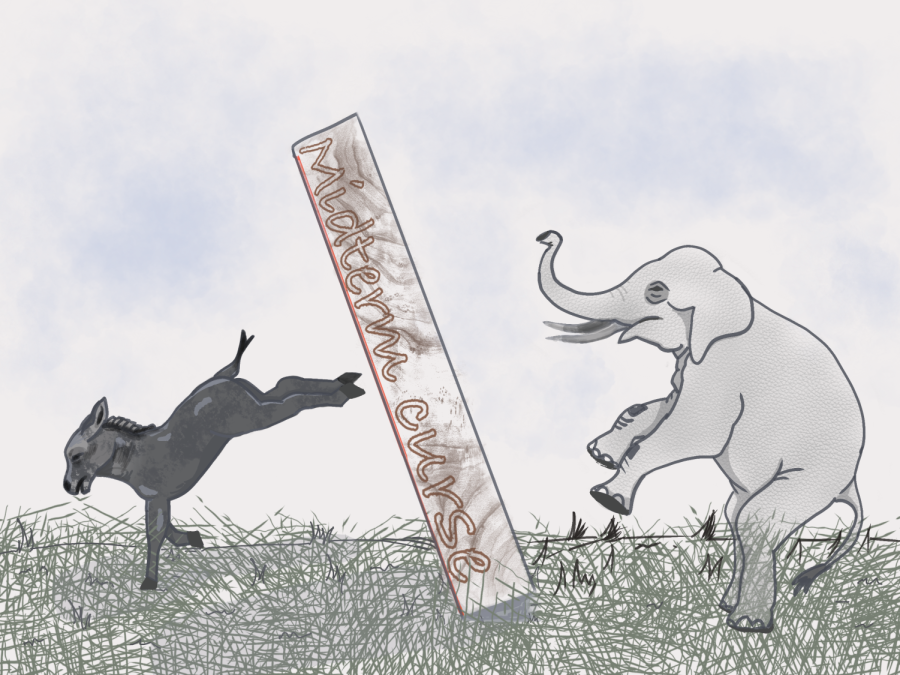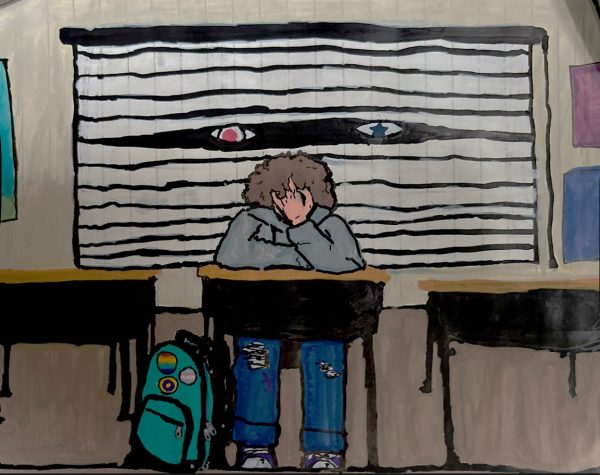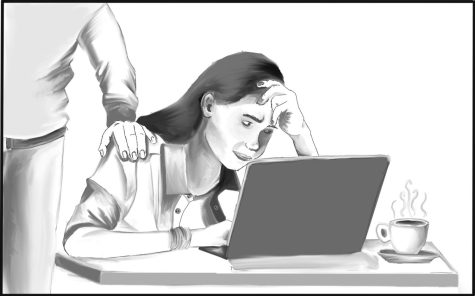Democrats Face Roadblocks to Retain Control of Congress
According to polling conducted on Sept. 30, over half of the country (51.9%) disapproves of President Biden’s performance.
Often deemed the “midterm curse,” midterm elections tend to be an unpropitious time for the party that holds the presidency, considering the record of off-year elections adversely impacting presidents’ parties 93% of the time since the Civil War.
These outcomes often raise congressional roadblocks to the president’s agenda. Because loss of seats in Congress is likely for the president’s party, poll watchers are more interested in analyzing how drastic these losses will be, what their causes will be and what they can portend for the remainder of the president’s term.
The House of Representatives is far more susceptible to the emerging “red wave,” which has been forecasted since Democratic losses in 2021 and the nationwide rise of Trump-endorsed candidates. According to Politico, however, in the two months leading up to the election, the playing field seems to have become more leveled and, in turn, more unforeseeable.
In response to recent strides made by conservatives, especially in the Supreme Court, liberal voters have rallied to counter the GOP’s recent attempts to jeopardize the welfare of many at the expense of the unchecked liberty of a few. On many issues, Republicans have undermined the rights of marginalized populations while bolstering freedoms that have repeatedly been used to establish supremacy and erode egalitarian ideals.
Democratic efforts paid off substantially in August through the enactment of a range of policies including the Inflation-Reduction Act, Biden’s student-debt relief plan, his executive order for reproductive healthcare access, the CHIPS and Science Act and the PACT ACT for veterans’ health care benefits.
FiveThirtyEight offers insight regarding what factors align to consistently bring about the midterm curse. One contributing factor could be the “surge and decline” of voter turnout, often impacted by a concept known as “differential turnout.” Voters of the party out of power have a greater incentive to vote than the voters of the incumbent majority party as they likely desire to reverse the status quo.
BHS Social Studies teacher John Perse further elucidates this phenomenon.
“It is in the interest [of the party in power] to say that everything is going well, but it dampens down the intensity of those that would vote for them,” he said. “It is easier to promise change than it is to make and maintain change, which goes to show that there is a level of complacency. A positive aspect of partisanship, however, is that it inspires more people to get involved.”
The 2022 midterm elections could follow the upward trend of voter turnout established in 2018 when the turnout rose by a historic 11 percentage points from the past midterm of 2014, across varied ethnic groups and age groups.
Moreover, Gallup polling this summer suggested that 48% of Americans have given “quite a lot of thought” to the 2022 midterms, which is significantly higher than the prior high of 37% in the previous times the question was asked in summers between 1998-2014. Historically, as the midterms get closer, the level of voter engagement increases significantly.
Social studies teacher Pam Crossman also foresees higher voter participation this season.
“Ohio has 90,000 newly registered voters, which is huge for a midterm,” she said. “We are number two in the country with voter registration, behind Kansas. While we should anticipate a flip in Congress, it will be unlikely in our statehouse.”
Interesting analysis on the demography of new voters reveals that many new voters are women. However, Crossman suggests that this isn’t the whole story.
“One may be led to believe that the Dobbs decision that overturned Roe v. Wade was a catalyst for increased voter registration, which for some voters could very well be true, but as for the election, we’ll have to see whether or not the Supreme Court [decisions released] this summer have a continued longevity,” she said.
Sophomore Elizabeth Liu is concerned about the direction of the Supreme Court.
“We’ve always tried to think of the Supreme Court justices as being non-partisan, but right now, especially with the more conservative justices, the [court] seems to be pushing through in a direction that might not reflect what the majority of the American people want,” she said.
Liu is also worried about the blind partisanship of many voters.
“Even if people don’t agree with a specific candidate’s policy, they decide to vote for them solely because of their affiliation with that political party,” she said.
Factors Tipping the Balance – Gerrymandering, New Candidates, Approval Ratings
The origins of redistricting are complex and can profoundly affect political power. As a result, election outcomes may not reflect the choices made by the majority of voters due to the overwhelming influence of gerrymandering practices by both parties.
Following the 2020 Census, some states appointed independent commissions to draw legislative maps. However, many states still rely on the majority party to draw maps. Because Republicans currently hold a majority in statehouses, they can draw maps that minimize competition and maximize their chances of acquiring seats.
Perse emphasizes that Ohio is considered in the top 10 most gerrymandered states. Despite Ohio’s maps being repeatedly rejected by the Ohio Supreme Court, the redistricting commission has not settled on an equitable and fair map.
Since the 2022 midterm elections will reveal the consequences of the new maps designed for the first time on a large scale, Perse hopes that lines are drawn in a more representative manner.
“[Statehouses] have been called out on this, and yet because there’s no repercussions by the courts or how people vote, they will keep [redistricting in a partisan manner],” he said. “This is not an Ohio problem, it’s a national problem that goes back to the 1700s, and clearly the party in power will try to game the system in a way that makes it easier for them to stay in power.”
Perse emphasizes that partisanship and redistricting feed one another.
“Lately, the partisan divide has become much more pronounced, and that’s where gerrymandering has become attractive to the party in power,” he said.
Jonathan Rodden, a Political scientist at Stanford University, analyzes how Democrats have experienced remarkable losses due to their dense concentration in urban areas in his book Why Cities Lose.
Senior Sam DeYoung, who is newly registered to vote this November, explains this concept in more detail.
“A lot of the more populous areas are more liberal but gerrymandering favors all the farms, which have more Republican people,” he said. “Because the population density in these areas is low, they see the need to gerrymander.”
Crossman explains that Gerrymandering also makes our politics more polarized.
“When gerrymandering takes place, the candidates get more and more extreme even though the voters are actually quite centrist,” she said. “So, it’s only going to increase people moving to the outer parts of the political spectrum.”
“It’s my understanding that until the next census, redistricting will tip in favor of Republicans,” she added.
Senior Jack Miller, who is also newly registered to vote this November, shares his perspective on current political polarization.
“I think ideologically we are not shifting in a red direction, but we are moving farther away from what we can agree on,” he said. “Especially in gerrymandered Republican states, conservatives and those who control that state are more vocal as they are more extreme.”
“Normally, it’s the extreme 10% that are the loudest, which is why we see an overrepresentation of their ideas,” he added.
Liu observes how this dynamic plays out in the Republican party.
“Instead of nominating more moderate candidates to sway Democrats to the Republican end, they’ve shifted in the opposite direction, nominating ultra-MAGA Trump supporters,” she said.
Crossman explains, however, that Ohio’s district maps may not stay in place until the next census.
“Ohio has a stipulation that if the parties do not agree on the determined map, the map will only stay in place for four years,” she said.
Recent New York Times analysis suggests that gerrymandering doesn’t seem to be as formidable a force in contorting popular opinion today, especially compared to maps in the past decades.
Nationwide, this year’s map is the “the fairest House map of the last 40 years.” Nonetheless, certain states, like Ohio, are disproportionately affected by recent gerrymandering.
Other detriments to the Democratic party’s fate include the fact that many incumbent Democrats are heading out, stepping down, or seeking new positions. As of now, according to Reuters, 30 Democratic members of Congress have announced their decision to step down, which is an unprecedented high — a record-breaking number since 1992 for the party.
Some Republicans are also choosing to step down, such as Ohio Senator Rob Portman, potentially due to divisions in the Republican party caused by obligations to the former president’s agenda.
Additionally, midterms have a reputation for serving as the referendum on the president’s approval rating.
While the president’s party tends to get penalized in the midterms regardless of whether the country is doing well or not, it may be exacerbated by the current crises the nation is enduring on both national and international fronts.
According to polling conducted on Sept. 30, over half of the country (51.9%) disapproves of President Biden.
Perse offers further insight into President Biden’s situation, and how the American public should be mindful of his circumstances.
“I do not personally think he’s a great president, but I don’t think he was trying to be a great president,” he said. “In my view, he’s brought a certain level of stability… a certain calming approach. Is that the mark of greatness? Perhaps not, but it’s something we’ve needed.”
“If you expect the leader to be all things, to all people, all the time, you’re going to be disappointed,” he added. “Even great presidents have made colossal mistakes. The expectation is often that the leadership will solve the problem when the best we can get is to better manage the problem. A lot of these problems might not be solvable because there are a lot of moving pieces.”
“[Voters] become victims of our own hopes and expectations, and while we need to have them, we also need to be realistic,” he concluded.
Political analysts, politicians on both aisles, and even some historians have drawn parallels between President Biden and President Carter. As inheritors of pre-existing struggles and tensions that have broadened during their tenure, both presidents have not necessarily caused but have overseen a nation experiencing malaise.
While the nature of the domestic issues and congressional realities they have faced may differ, both presidents have dealt with similar problems. Moreover, the lack of robust communication from both leaders strengthens the belief that they were not in a position when the man, the times, and the people all aligned.
Perse remarks on the comparisons between the two presidential terms.
“While history runs in cycles, to say that we are in a repeat of the Carter administration is far too simplistic.”
A Republican takeover this fall could bring greater gridlock, further derailing the Biden administration’s agenda.
Regardless of the outcome, Perse stresses the importance of civility in the political process.
“[The party] in control of Congress [should] not go after the other party,” he said. “Whichever party controls both houses should promote its own agenda — try to fulfill its agenda — not use it as a platform for revenge.”
Although compromise between parties might not be as viable as it has been in the past, compromise within parties has become crucial as seen with recent legislation passed by Democrats.
Ohio as a Political Battleground
Rob Portman’s Senate seat has become important in the battle for control of Congress. Candidates Tim Ryan (D) and J.D. Vance (R) are neck and neck in most recent polls, and the most significant factor may be long-term trends, which tilt in favor of Vance, according to Politico.
Tim Ryan, currently a representative of Ohio’s 13th district, has thoroughly utilized the preceding summer months. He has spent $8 million on television ads, outspending his opponent eight-to-one and from May 3 to Aug. 12, has held 20 more public events than Vance, all of which were open to press.
Ryan has established himself as a moderate Democrat, emphasizing the need for investment in infrastructure and industrial development and supporting women’s right to reproductive autonomy.
Also, Ryan has supported the CHIPS and Science Law, seeing it as a precursor for Ohio to become the “arsenal of energy,” as the law directs resources to building microprocessor manufacturing facilities to wean the United States from dependence on foreign technology.
While Ryan’s message has already been widely disseminated in Ohio, Vance is now receiving strong monetary reinforcement from Senator Mitch McConnell’s PAC.
Even though the race is tight, there has been minimal open debate between candidates, and more alarmingly Governor Mike DeWiine has refused to debate his opponent Nan Whaley.
Perse sheds light on the issue of debates between candidates.
“We are getting to a point where [Americans] are asking ‘Should there even be debates?’ Debates are not always productive, but nevertheless, they give the voters more information to make an informed choice,” he said. “Now, debates result in personal attacks, not to say that hasn’t ever happened before, but it seems that there is no pretense of discussing issues. I am seeing things in American politics that I know have existed [in the past], but I have never seen it day after day with such intensity.”
Crossman adds that it is not just the Senate race that has taken a profoundly divisive course, but also the gubernatorial election.
“It’s a close race between Nan Whaley and Mike DeWine,” she said. “Ultimately, this and the Senate election is going to come down to voter turnout.”
“Flipping a Senate seat and defeating an incumbent governor are difficult, and if all of the 90,000 newly registered voters show up, anything can happen,” she added.
As the midterm elections approach, there are many issues at stake, but one that is particularly important to voters is inflation. Bringing supply chains “back to normal” is essential but contingent on our next moves in international affairs and multilateral negotiations.
The abortion issue, which has the most immediate impact on young women, especially those of color, has reminded many Americans not to take for granted the rights protected under the right to privacy.
With arrests for illegal crossings at the Southern border at an all time high, immigration ranks as a top issue that Republicans are amplifying.
The list of issues is endless, making voting crucial for all positions and issues on the ballot.
Crossman urges eligible voters to think critically about the decisions that will be made this fall and consider how they will — directly or indirectly — affect their lives.
“There are a lot of people that say “I don’t do politics,” but as we know, if you don’t do politics, politics is going to do you. So, you’re either at the table or you’re on the menu,” she said.
Is BHS Preparing Its Students to Be Active Citizens?
Voter turnout is under 50% for young adults in the United States, lower than most other countries where data is available. So it is important to consider whether American high schools such as BHS are equipping students to participate in the political process.
Liu feels that some BHS courses have stimulated her interest in politics.
“Learning about [American history] in APUSH has sparked my curiosity on how these systems have progressed over the centuries,” she said.
Miller and DeYoung concur that the BHS social studies department demonstrates the past’s relevance to the present.
However, when it comes to seeing oneself as a part of the fundamental democratic process, there remains ample room to reinforce the importance of political engagement.
“It would be really important for students to know the process of voting, how to attend public meetings to determine their political affiliation, and learn the basics of [personal] finance and economics,” Liu said.
Perse explains the challenge of teaching high school students to be more politically engaged.
“Tell an 18-year-old: “make sure to register to vote!” It’s sort of in a vacuum and it’s too abstract, unless you start connecting real issues to the voting,” he said. “But, also, to put those issues up front can [inevitably] cause someone to be offended.”
Even if we do register 18-year-olds to vote, how can we demonstrate the relationship between individual decisions and national action to make voting relevant?
In her human rights & conflict class, as well as in AP US Government, Crossman goes to great lengths to inform her students about the political process.
“I always do voter registration and have already pushed many seniors and many of them have registered,” she said. “In class we talk about current events a lot to remind [students] that they are stakeholders and have a voice.”
“I’m really proud of staying in contact with alumni whom I helped register to vote as well,” she added. “I send them messages and links so that they can get absentee ballots and other information.”
Even so, the significance of midterm elections is often unfairly diminished in political discussions, which can be somewhat attributed to the way the media covers politics.
Crossman emphasizes the importance of informing voters about state and local politics.
“As a society, we need to find a better way to communicate what’s going on in Columbus more than what’s going on in the White House,” she suggested.
For this reason, DeYoung also encourages his peers to vote in local elections.
“With a presidential election you’re likely not getting a change in the infrastructure of a specific place, so if you really want to see these types of changes happen, you need to vote locally,” he said.
Miller believes that open discussion of political issues would benefit students’ civic education.
“I think the common advice is to stay quiet on your political views, but if everyone discussed their views and we started respecting how they discuss their views, politics would be less of a taboo topic, even if we couldn’t come to a consensus on specific issues,” he said.
However, Miller cautions against forming clubs based on political views.
“It’s dangerous with the Young Republicans’ club or any political club because they tend to become echo chambers more than places for political discussions, which needs to be avoided because they can amplify ideas that are poor,” he said.
Crossman believes that expanding a student’s worldview requires a holistic effort, but is well worth the time and effort.
“[We need to] make our standards more action-focused as opposed to rote memorization,” she said.
She feels that the current curriculum leaves out many important aspects of how citizens participate in the democratic system, such as familiarity with their elected officials and knowing what to do when you get a jury summons.
“We have ramped up the focus in certain areas to the detriment of civic education, social studies, and what it means to be a good citizen and meet your civic obligations,” she said.














